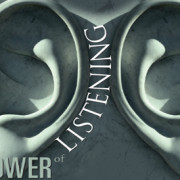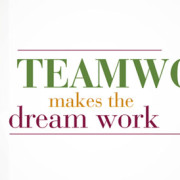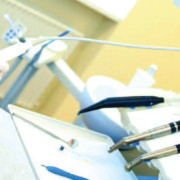Death of a “Salesman” Birth of a “Helping Professional”
People Love to “Buy” but Hate to be “Sold” to
ABSTRACT
For most dentists the concept of “selling” was not something they signed up for when applying to dental school. In fact for many clinicians, especially first-decade dentists when they hear the word “sales” it conjures up images of manipulating people into parting with their hard-earned money.The underlying mentality is that; we are a medical profession and should simply be able to tell people what they need and they should just trust us and understand our advice. This viewpoint can be somewhat self limiting because most of us practice in a fee-for-service environment where even if the patient has dental insurance, the average policy does not completely cover a lot of what modern dentistry has to offer. This means that our ability to deliver optimal health and wellness to society will rest largely on our ability to inspire our patients to desire and pay for what we can do for them.
So what is it about this concept of “Selling” that so many of us in our profession feel so uncomfortable with? Is “selling something to someone” really a bad thing? Or is it our approach to selling that determines its ethics and integrity? Does it have to be a manipulative dishonourable process or can it be something beautiful and empowering that connects us to people and empowers us to help them? I think the answer to this question depends largely on how we perceive and define the process of “selling” in our own mind. My observation is that it is the old school negative approach to “selling” usually applied by what we call “pushy sales people” that most clinicians have an aversion to. You know the ones … the fast talking … manipulative … sly … heartless … dishonest sales person who has poor listening skills and could care less about what you think because they are focused on one thing only “closing the deal and getting your money.” Selling doesn’t have to occur this way. How we decide to deliver the selling/buying experience to our patients is completely within our control. It is a conscious choice each of us can make.
How you define the process of “sales” in your own mind will be powerful in influencing how you deliver the buying experience. I recently asked a group of dentists who said they hate “selling” to create an ideal definition of term “sales” based on how they feel about it … here is what they came up with …“sales is a process of coercing someone into buying something they don’t want or think they need.” Wow! If that’s how you allow yourself to see selling then everything you say to your patient during a case presentation will be tainted with this negative belief system. In silent, powerful, and unseen ways you will unconsciously project or mirror these beliefs on to your patients through your choice of words, body language, and through your overall approach to the entire process.
Your underlying motives and beliefs have everything to do with how you present yourself and your ideas to people. With all the beautiful advances modern dentistry has to offer today, if we are to succeed as clinicians in the 21st century it is imperative that we don’t view case presentations as a process of convincing customers or pushing them into things. That’s why we must redefine the term “Sales” and give it a more positive and purposeful meaning that can guide us towards delivering a more positive buying experience to our patients. The great philosopher Plato said “the beginning of wisdom is the definition of terms.” Our new improved meaning for selling should be based on the process of what we are really trying to achieve when we communicate with patients. It should sound something like this … “sales is a process of engaging someone intellectually while enabling them to commit themselves emotionally to make the decisions and take the actions towards a desirable outcome” or more simply put “sales is a process of helping people to make decisions that will add to their quality of life.” This means that our entire case presentation must be converted from the all too common one-sided regurgitation of dental information (product and services dump) to a more interactive process that gets patients involved and guides them towards discovering for themselves that which is in their best interest. When you sell with ethics and integrity you don’t have to approach people with the intent of selling them something: rather, your goal will be to gain rapport and understand their objectives so you can help them get what they need.
Have you ever been sold something and then days or even months later wondered why you bought it? When you came to the conclusion that you were “sold to,” how did you feel – about yourself, the salesperson who sold it to you, and the company that he/she works for or owns? However, you’ve also bought products and services that were unnecessary but you didn’t feel the same negativity towards the salesperson or the company. Why? In those instances, you were an integral part of the purchasing process. If your sales process is a one sided regurgitation of procedures and techniques then this may not be very emotionally appealing to patients and they will not buy. To counter this challenge many sales training programs, seminars, or books on selling present it as a series of strategies, gimmicks, or attempts to control behaviour – all designed to get a potential buyer to say “Yes.” The problem with these teachings is that they often promote manipulative sales techniques. They teach strategies like tie downs, open probes, get them while their hot, overcome objections, up sell (would you like a crown with that) … probe for the close (any reason we can’t schedule today?). These manipulative sales techniques may raise your batting average slightly on a per incidence bases but they do not form the foundation for long-term trusting mutually rewarding relationships with patients who are committed to preserving and enhancing their life-long dental health in partnership with your office. In fact; while coaching hundreds of dental professionals it is my observation that when patients say “yes” based on how they were sold in many cases they may not actually be “committed” to the treatment they are accepting. If you pressure patients into accepting treatment you can often get them to “comply” with treatment, but when they comply (act of being pressured into something) they do not emotionally commit themselves to the process or to the potential positive outcomes. Have you ever noticed the common phenomenon with patients who hesitantly accept treatment under sales pressure? They are often very difficult to completely satisfy? No matter how good you make the clinical outcome they seem to find reasons to be dissatisfied. Then on other hand I’m sure you have had patients for whom you were not fully satisfied with your clinical excellence yet this patient just loved your work and referred their friends and co-workers. I believe the difference between these two scenarios lies mostly in the level of commitment that was achieved with the patient during the selling process (case presentation). There is a big difference between compliance and commitment. When patients comply with care we tend to become mostly responsible for them. When they commit to care they tend to take more responsibility for themselves and for the clinical outcomes. Committed patients tend to become more positively involved in their care which is evidenced by their behaviour in the practice – following clinical instructions, realistic expectations of clinical outcomes, keeping their appointments and paying on time etc. Pressure sales is what most of us have an aversion to because it can lead to pressure case acceptance which means that we end up babysitting the patient through the entire process while looking like a pushy salesman and feeling undervalued and under-appreciated.
Human beings are emotional creatures who process all decisions they make with their emotions/feelings. This means that when our patients walk into our practice they walk in with all of the emotional baggage related to things that are going on in their life at any one time – trips, job, relationships, other health concerns, family goals/challenges, new car, self image and self esteem issues, rent, credit card debt, going back to school, etc. For basic procedures that are mostly covered by insurance we can usually get away with telling them what they need without focusing on their current life circumstances and they’ll usually accept treatment. However; when the fees get higher and the complexity of care becomes more involved we must factor into our communication the fact that patients have a life outside the office and then with the patient in the driver seat we must embark on a co-discovery journey of fitting the dentistry into their lives not into their mouths. To do this well we must reconnect with our authentic non-dental self. Which is the way we thought and spoke before the world of dentistry started crowding out our thinking with dental terms and industry jargon. This is why social skills are so important. These have little to do with talking, or having the “gift of gab.” They’re more about communicating with people – asking questions, listening, understanding, and having empathy and rapport.
Social skills are demonstrated when you ask questions and listen, when you understand different behaviour or communication styles, and when you adjust your style to fit other people’s styles. It’s the ability to understand the unspoken. To read body language. To pick up on voice tones, inflection, and facial expressions. It’s being able to intuitively crawl inside other people, then think and see the world as they do. It’s the willingness to listen to people without biases. To understand their viewpoint. To suspend your view of how things are and understand their beliefs and opinions. Excellent social skills help us jump on board other people’s trains of thought and ride with them as co-passengers. This is the stage on which the fullest scope of modern dental services can be delivered.
Selling really is a process of guiding people towards self discovery and hope. It’s a process of engaging a person’s heart and imagination towards something that does not yet exist in their lives. Selling is best achieved by listening to people. In fact, listening is the greatest skill you can use for strengthening your communication excellence. It is also the greatest tool we have for releasing potential in others. This talent can save a marriage, make you a better negotiator, heal a damaged friendship, increase your sales, or strengthen your leadership and team unity. It has been said that the greatest need of the human soul is the need to feel heard and understood. Give the gift of “High Level Listening” to your patients on a daily basis and you will in fact be strengthening your ability to sell by leading them towards great decisions that will add to the quality of their lives. One of the easiest ways to distinguish the difference between an effective treatment coordinator or dentist and one who needs more skills development is to watch how that person interacts with the patient. When he or she does all or most of the talking, it’s likely acceptance of treatment will either be delayed (I need more information, I want to think about it, etc.) or denied completely. People really don’t care how much you know or what you can do until you show how much you care. Patients don’t like “product dump” speeches. When they sense one coming on they will tend to tune you out.
The next time you discuss treatment options with a patient ask yourself the following four questions
- Whose dental condition/opportunity is it?
- Who’s recognizing the condition/ opportunity?
- Who wants to treat it?
- Who’s accepted all potential treatment outcomes?
If the answer to any of these questions is you, and not the patient, then we do not have patient involvement. No one can force health on a patient, it has to be desired – a goal. No one can force a patient to show up for appointments. They show up for appointments that they want and they alsoBARRY show more appreciation for treatment they choose. The process of patient involvement is called co-diagnosis. Co-diagnosis is the development of a partnership. It’s the act of assisting patients to “discover” themselves and participate in the diagnosis. People really are interested in themselves. Our job is to help them to discover themselves and any potential problems/opportunities. It’s the patient’s job to decide what level of health and wellness they choose for themselves. We dental professionals spend an awful lot of time trying to convince people to have their dentistry done. We are excited about all the options that we can provide. But we fail to realize that before we can get the patients enthusiasm, we must first help them develop their desire for the services. Patients will only agree to services they want (not need). The Greek philosopher Socrates talked about the use of questions to guide people towards developing ideas and conclusions in their own mind. By leading people through a series of focus questions we facilitate their “ah ha” moments but they take ownership of their breakthrough thoughts. Do you lead your patients through a process of self discovery that lets you highlight the range of possibilities available to them – possibilities that they would not have identified without you?
The following are 10 tips we can use to strengthen our case presentation skills and increase case acceptance
- View the patient as an ally and adopt a healthy view of selling
- Listen twice as much as you speak
- Take notes during the presentation
- Make a comprehensive chart including information regarding the unique life circumstances, views, and emotional desires of the person attached to the teeth
- Begin creating an ongoing list of deep probing open ended questions
- Take the time to connect on a personal level with your patients
- Identify their needs 8. Fit the dentistry into their needs
- Don’t sell raw dentistry (products and procedures)
- Communicate beyond this; to the quality of life impact (features and benefits) the dentistry will have on their lives
- Your values and attitudes are projected to patients. Be open and honest and they will trust you
At the end of the day it comes down to this, we are all born as human beings not as customers or patients. We are all people – our patients are not customers, they are people. Without people we have nothing, but with people we have something bigger than dentistry. By embracing the human condition we can change our language and the patients overall perception of us and what we have to offer. We can all boost our case presentation skills and enhance case acceptance by learning to more effectively communicate in our patient’s language. Dentistry is a helping profession and “sales” is a helping process. By altering our thinking and approach slightly we can easily shift the focus from “Us” and the procedures we sell to “The Customer” and the quality of life impact our services will have on their lives. This shift in thinking will enable us to communicate with our patients in a more buyer-based, service-focused and solution driven way, and we will bring honour and dignity to this whole concept of selling within the profession dentistry.

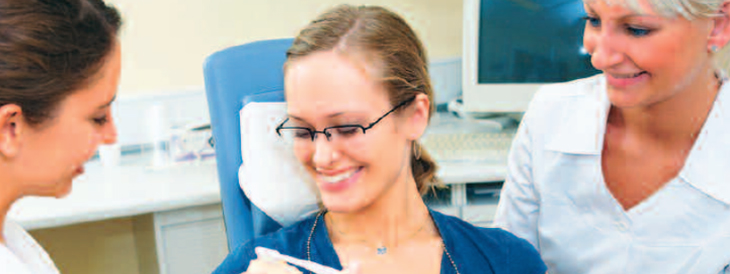
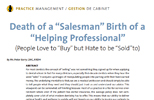 Originally Published in
Originally Published in 